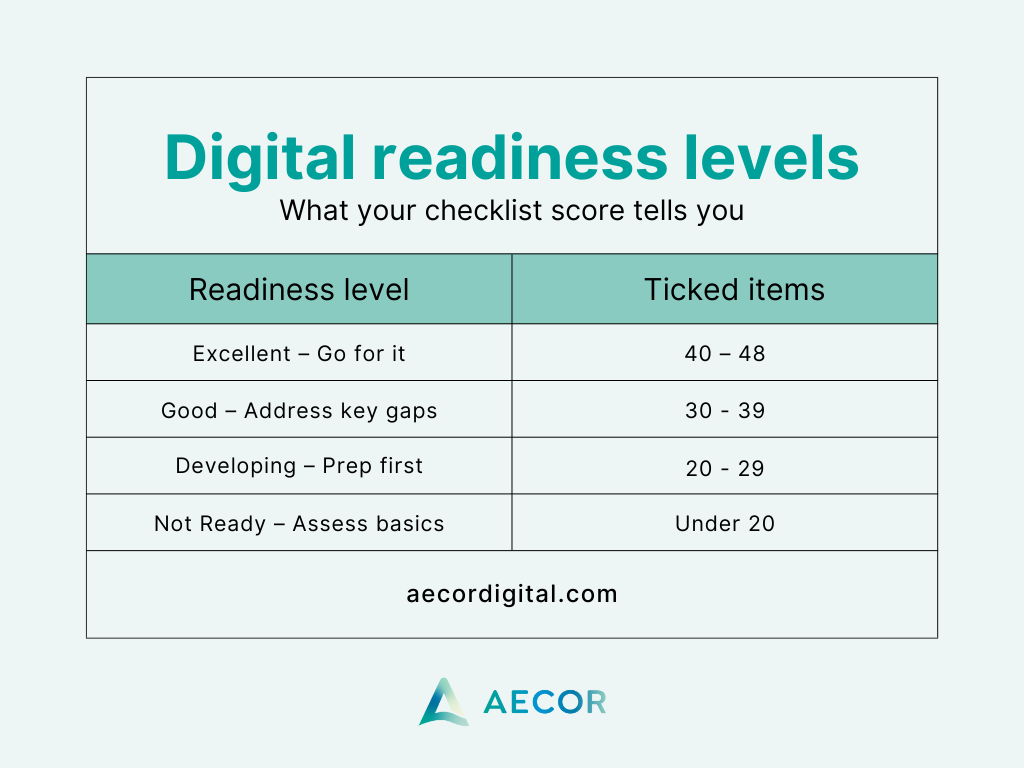Is your UK SME ready for business process automation? Take the checklist

In today's fast-paced market, UK SMEs face constant pressure to get more done with less. One powerful way to tackle this challenge is business process automation (BPA), especially when paired with AI and smart tech partnerships. Automation helps you ditch repetitive manual tasks, reduce costly errors, and give your team more time to focus on activities that truly drive growth.
However, before diving into automation, it's crucial to assess your organisation's digital readiness. Implementing automation without proper preparation can lead to suboptimal results.
Whether you're in operations, product management, or IT, this practical checklist will help you quickly spot areas ripe for automation. It’s designed to ensure you’re making the most of your current tools, paving the way for smoother, stress-free automation.
The importance of digital readiness
Automation isn’t something you just plug in and forget, it has to fit your business like a glove. Identifying exactly where manual processes slow you down and checking whether your existing systems can handle automation is essential. Assessing your digital readiness upfront makes sure your efforts directly support your overall business goals and keep your automation initiatives practical, not painful.
Use this checklist to identify whether your organisation is operationally and technically ready to implement automation, and to uncover the low-hanging fruit you may already be able to automate using existing tools. Think you’re ready to automate? Let’s find out.
SECTION 1: Process visibility & repetition
Have you...
Mapped your core operational processes from start to finish?
Identified steps that are performed manually more than once a week?
Documented any manual workarounds or unofficial processes?
Found areas where work is passed between departments without tracking?
Log time-consuming email or spreadsheet-based workflows?
Spotted manual approvals or updates that cause bottlenecks?
Noted tasks repeated by different departments independently?
Identified any process that varies widely depending on who’s doing it?
Measured delays caused by task switching or double-handling?
SECTION 2: System capability & integration
Have you…
Audited your core systems for available automation features?
Reviewed CRM, finance, HR, and operations platforms for unused workflows?
Determine if your current systems support APIs or integration tools.
Identified software that lacks integration but is critical to your workflows?
Assessed whether you can extract or sync data from legacy systems?
Checked for existing licences for tools like Zapier, Power Automate, or Integromat?
Verified where cloud vs. on-premise infrastructure limits automation?
Established a list of ‘must integrate’ platforms for automation planning?
Evaluated software vendor’s roadmaps for future automation features?
SECTION 3: People & roles
Have you…
Assigned an internal sponsor for automation initiatives?
Appointed process owners across departments?
Engaged frontline users in process review or ideation?
Trained at least one internal user in automation or scripting tools?
Created time in schedules for automation planning, testing, and feedback?
Measured internal resistance to process change or system updates?
Allocated someone to maintain or monitor automated workflows post-launch?
Is ensuring process improvement part of someone's KPIs?
SECTION 4: Data accessibility & structure
Have you…
Centralised key data sources (e.g., customer info, transactions, inventory)?
Cleaned and de-duplicated business-critical records in the last 6 months?
Ensured consistent naming conventions across systems?
Evaluated where spreadsheet-based processes could be replaced with databases or forms?
Tagged or categorised data to support automated decisions?
Identified where human judgment is currently required due to poor data quality?
Set validation rules for new data entries in key systems?
Confirmed that essential data can be queried, extracted, or reported easily?
SECTION 5: Risk, security & compliance
Have you…
Identified processes involving personal data or regulatory risk (e.g., GDPR)?
Reviewed data access policies for automated tools or bots?
Confirmed that automated decisions will be logged and auditable?
Ensured role-based access control (RBAC) is enforced across systems?
Mapped your automation workflows against existing security policies?
Included compliance team input in automation scoping?
Planned alerts or exception handling for automated processes that fail?
SECTION 6: Strategic & financial alignment
Have you…
Defined a business case for automation (time saved, effective results, data accuracy, cost reduced, output increased)?
Prioritised automation targets by ROI and effort level?
Considered phased implementation (starting with low-risk/high-impact tasks)?
Budgeted for automation tooling, training, or consultancy if required?
Set performance indicators to track automation success post-launch?
Benchmarked your maturity level against peers in your industry or market?
Included automation in your annual operational improvement strategy?
How to Interpret Your Automation Readiness Score
Use your total number of "Yes" answers across all checklist sections to find your readiness level below. This score helps identify how prepared your organisation is for automation and where to focus next.
Ready to turn your checklist into action?
If you're looking to boost your workflow efficiency and unlock the power of business process automation, let’s chat. Our team can guide you every step of the way, ensuring your automation journey is smooth, practical, and aligned with your goals.
Schedule your free digital readiness consultation today.
Related insights
What our clients say













